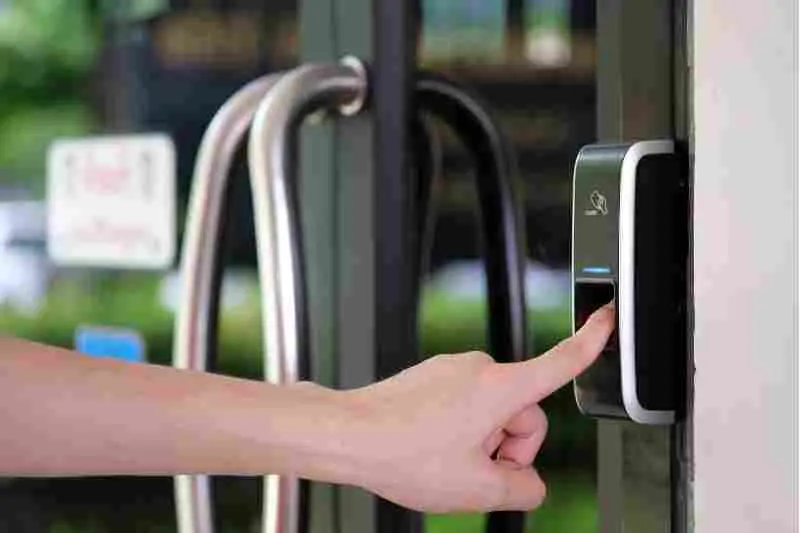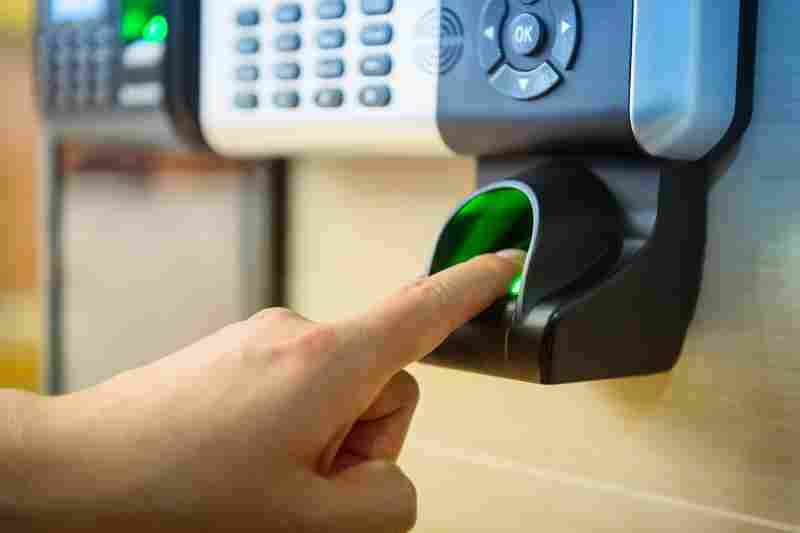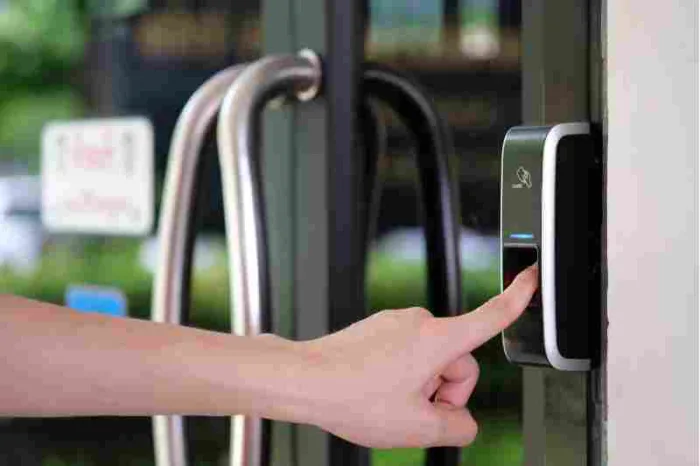Key takeaways
- Biometric deadbolts are a type of lock that uses fingerprint, facial, or iris scanning to verify a person’s identity.
- To use a biometric deadbolt, a tenant places their hand or eye where the sensor can view it. The sensor reads the tenant’s unique identifiers and compares them to an internal database. If there’s a match, the door unlocks.
- Fingerprint door knobs are easy to use and secure. But drawbacks include inconsistent unlocking and increased costs.
- The best way to use biometric deadlocks is alongside other access control options, like keycards or smartphone app-based unlocking.

Have you recently unlocked your phone with your face or your fingerprint? If so, you’re a proud user of biometric fingerprint access. And what if you could bring that same convenience and effortlessness to access control on your property? Fortunately, you can by investing in biometric deadbolts.
In this post, we explain what biometric deadbolts are and how they work. Then, we go over their pros and cons. Finally, we outline the most efficient way to use them on your property.
This post covers:
- What is a biometric deadbolt?
- How does a biometric deadbolt work?
- Pros and cons of biometric deadbolt locks
- The best way to use biometric door locks
What is a biometric deadbolt?
A biometric deadbolt is a lock that uses a person’s unique physical features as a credential to lock and unlock doors. For example, applying your thumb to a deadbolt lock will grant you access.
Common biometric credentials include:
- Fingerprints
- Voice recognition
- Facial scanning
- Palmprint scanning
While this technology seems brand new, we’ve been using biometrics to identify people for over a century. In fact, the first fingerprint classification system was invented back in 1892
And these days, people use their fingerprints and facial scans for many reasons. From unlocking your smartphone to checking into flights without paperwork, the popularity of biometric security is growing exponentially.
In biometric access control, fingerprint deadbolts count on the uniqueness and irreplicability of people’s unique features to add an extra layer of security to the process of opening a door or gate.

How does a biometric deadbolt work?
A biometric deadbolt uses a fingerprint facial scan to unlock the door and allow a tenant entry.
When a tenant wants to open a biometric deadbolt, they follow these steps:
- Tenant uses the sensor. Depending on the type of biometric credential you’re using, this step will vary. A tenant using touch ID will press their finger up to the sensor. Conversely, a tenant using facial or iris recognition will present themselves to a camera.
- Sensor computerizes data. The sensor takes the data points it’s received and translates them into a string of letters and numbers. Then, the sensor sends this string to the control panel for further verification.
- Control panel verifies identity. If the string matches an existing string in the control panel’s database, the control panel considers the tenant’s identity verified and signals the lock to open.
- Lock opens. The deadbolt retreats back inside the lock, allowing the tenant to open the door.
Watch how ButterflyMX works:
Pros and cons of biometric deadbolt locks
So, you’re considering biometric door locks for your property. First, let’s review their pros and cons.
Biometric deadbolt pros
- Keyless access. Brass keys, or even more modern access credentials like fobs or key cards, present a few problems. Tenants are constantly losing physical credentials — and you have to spend money replacing them. Instead, you might depend on biometric access so that your tenants can enjoy the convenience of a keyless entry door lock.
- Intuitive. In many cases, access is as easy as placing your finger on a pad or posing for the biometric door lock’s camera.
Drawbacks of biometric deadbolts
- Expensive. Biometric deadbolts are some of the newest, most complicated locks on the market. If your budget is a factor, you might be better off choosing a different kind of credential.
- Inconsistent. If there are adverse weather conditions, like rain or snow, the sensor might work inconsistently. Further, moisture or natural skin oils might prevent a fingerprint deadbolt door lock from reading a print correctly. Or a camera obstruction might negatively impact the performance of a facial recognition sensor.
- Not touchless. Many property managers and tenants have started to see the hygiene and health benefits of touchless access options, like a smartphone app that opens the door. Unfortunately, if you install a fingerprint scanner, touching it is unavoidable.
- Unfit for every context. While biometric deadbolts certainly secure doors, you might run into problems using the same biometric technology for every context. Take a vehicle gate, for example. A tenant might have to lean, or even exit, their car entirely to access a biometric sensor. Meanwhile, a vehicle sticker would allow them to just drive right through.
Are fingerprint deadbolts safe?
Fingerprint deadbolt locks are quite safe and secure. However, you have to balance the security of a biometric deadbolt with the reliability of the technology.
Whether you’re talking about somebody’s fingerprint, iris, or face, there are millions of little data points, measurements, and points of comparison that ensure that no two faces or thumbprints are the same. Modern scanners and technology allow us to use these unique data points to verify a person’s identity.
However, in practice, using a sensor might take longer than it would in a perfect world. A person with glasses or sunglasses might have trouble with a facial scan, or rain might require a tenant to try a deadbolt with a fingerprint scanner multiple times. Despite the high levels of security, this might result in a negative experience for a tenant.

The best way to use biometric door locks
The best way to use biometric deadbolts is to use them alongside other types of locks and credential methods so that your tenants always have a way to open the door.
Fingerprint deadbolt door locks are a safe choice for many properties. However, your tenants may have difficulty unlocking a biometric deadlock if the weather is harsh or if the sensors need maintenance or recalibration.
Every property has different needs. The high cost of a biometric deadlock might mean that you only get to use one or two throughout your whole building. And depending on how integration-friendly your existing access control system is, adding new locks to your property can go one of two ways.
First, you might be able to easily add new locks and increase tenant trust and security. Second, installing a new lock could be an arduous, weeks-long process. This process may disrupt tenant routines and influence them into looking to sign new leases.
The most integration-friendly access system for biometrics
No matter where you place your deadbolts, you should be using an access control system that makes swapping locks and editing tenant permissions easy. As a result, your property is always secure, and access is always convenient.
Take ButterflyMX’s powerful management dashboard, for example. We integrate with dozens of smart lock manufacturers, ensuring that adding new locks and securing new areas of your property has never been easier.
Furthermore, ButterflyMX offers multiple ways to open the door, including fobs, vehicle stickers for gates, and a smartphone-based app. All of these are perfect complements to any biometric deadbolt you might choose.






